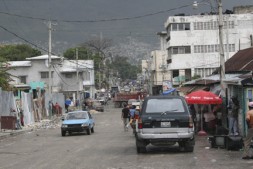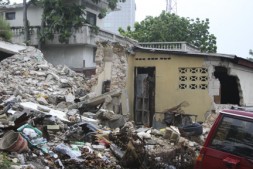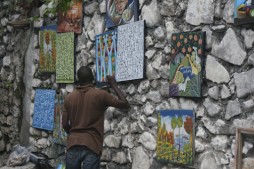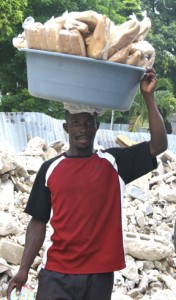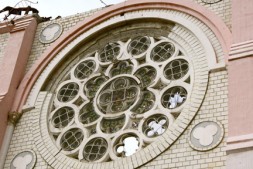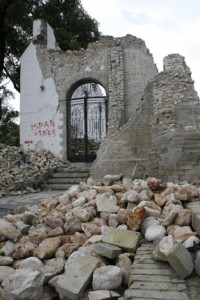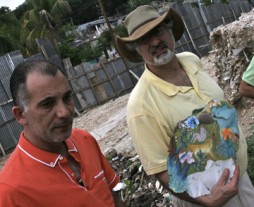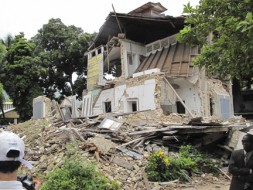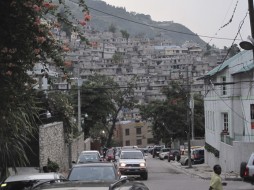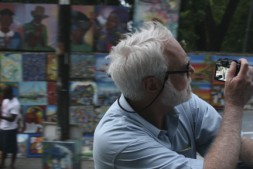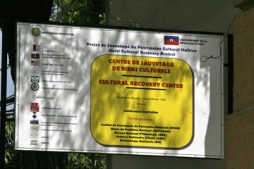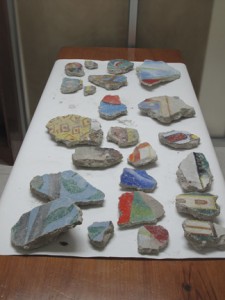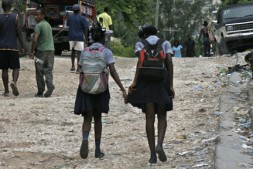On the road in Haiti: The Secretary’s travel journal
Haiti. Its complex history is filled with triumph and tragedy, and more than its share of bad luck. A high point came with the successful slave rebellion that cast off the shackles of colonialism in 1804, creating only the second independent country in the Western Hemisphere. Fate, however, did not favor this newly minted republic. From the outset, nations with continuing traditions of slavery, including our own, did not see fit to support Haiti and its leaders. Once abundant natural resources have been poorly used and political instability and poverty have dogged Haiti for generations.
Given that Haiti lies in “hurricane alley,” it seems cosmically unfair that the country also lies perched on a restless part of the earth’s crust where earthquakes occur with some degree of regularity. With the arrival of Europeans, written history first records a significant earthquake in 1564. Others follow in 1701, 1751, 1770 and 1783. In 1842, thousands of people died in an earthquake that destroyed Cap Haitien and produced a large tsunami that wreaked havoc on other shoreline cities. The earthquake gods were silent until a cool late afternoon on January 12, 2010, when a magnitude 7 event took only 35 seconds to destroy the most populous city in the country, Port-au-Prince. The media documented the disaster with 24-hour coverage of the chaos as shocked survivors tried to move the rubble of collapsed buildings by hand. These images were personal reminders of my days as a young faculty member at Stanford University when I served on earthquake reconnaissance teams.
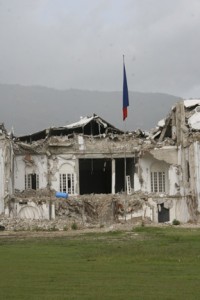
The Presidential Palace was among the buildings destroyed by the earthquake in January. (Photo by Ken Solomon)
Inevitably, the extent of the tragedy from an earthquake is always greater in poorer countries where building codes are either non-existent or difficult to enforce and the infrastructure for emergency response is not robust.
In the days following the earthquake our understanding of the depth of the disaster deepened. Estimates are that about 250,000 people died and 300,000 were seriously wounded. More than 1,200 schools, 30,000 commercial buildings and 250,000 residences were destroyed. The effectiveness of the Haitian government was drastically reduced since all major public buildings, including the Presidential Palace, collapsed. This was no ordinary natural disaster and it seemed likely to overwhelm a nation that faced challenges before the earthquake was visited on it.
Many of us at the Smithsonian were moved to find a way to assist the Haitian people and their government in this time of need. The question was how? It seemed logical to look first to the museums, galleries and historical buildings that preserve the country’s history and culture. While Haiti is a poor country, it is rich in art and culture that, in themselves, form an important part of the national economy. Art has proven to be a central and continuing resource for the people of Haiti to express their hopes and aspirations. Haitian paintings delight the eye with the bright colors of the tropics and the deep hues of the surrounding seas. They depict a people who exude humanity and celebrate life. Preliminary reports showed that damage to the museums, churches and other cultural institutions was extensive. Photographs showed artworks and documents—icons of Haitian history— lying exposed to the elements in the rubble. Instinctively, we knew that here was where we could do the most to help. As the world’s largest museum and research complex, the Smithsonian has an extensive reservoir of expertise in preservation and restoration of art and historical documents.
In addition to expertise, the Smithsonian has people with big hearts who care. One of these is Richard Kurin, our Under Secretary of History, Art, and Culture. Richard has been with the Smithsonian for more than 25 years and knows the place inside and out. He helped create the Center for Folklife and Cultural Heritage Folklife Center, which gave him an ideal background to lead the Haiti project. It also didn’t hurt that Richard spent some time driving a cab in New York. The moxie that cab driving required would also come in handy in the days ahead.
Doing the right thing is not always easy, especially in the midst of a large-scale disaster. We knew that it was necessary that our plans be in accord with those of the U.S. and Haitian governments. Clearly, their first priority was saving lives, restoring a semblance of order and providing support for the people. Yet our work also had urgency because Haiti’s artwork and historical documents were at risk from the elements as well as theft—every day counted, especially with hurricane season approaching.
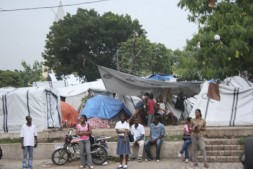
Thousands of survivors are still living in makeshift tent cities six months after the earthquake. (Photo by Ken Solomon)
Our initial inquiries received a positive response: In principle, everyone agreed the work was important and should proceed. We found allies at the White House through First Lady Michelle Obama and the President’s Committee on Arts and Humanities and at the U.S. State Department. In Haiti, First Lady Elizabeth Preval; Minister of Culture and Communication Marie Laurence Jocelyn Lassegue; and Minister of Tourism Patrick Delatour were supportive, with Minister Delatour also adding his imprimatur as the chair of Haiti’s Presidential Commission for Reconstruction. Minister Delatour is well known to us at the Smithsonian: He was a fellow at the American History Museum in the early 1980s and then worked with Richard Kurin when he served as the co-curator of the Haitian program at the 2004 Smithsonian Folklife Festival. Several other organizations chose to partner with us, including U.S. Committee of the Blue Shield, UNESCO, the Institute for Museum and Library Services, the National Endowment for Humanities, the National Endowment for the Arts, the American Institute for Conservation, the International Centre for the Study and Preservation and Restoration of Cultural Property, and others. Also joining us as supporters and providing the first major gift to help finance the operation was the Broadway League, a group of Broadway directors and producers who stepped up early when help was desperately needed.
With the partnership in place, Richard and a contingent of Smithsonian colleagues, ranging from preservation specialists to facilities engineers, made visits to Haiti to reconnoiter and establish a base from which we could do our work. What evolved was the Haiti Cultural Recovery Project, with the mission statement, “A project to rescue, recover, safeguard and help restore Haitian artwork, artifacts, documents, media, and architectural features damaged and endangered by the earthquake and its aftermath.” We also would work with the Haitian government to help train artisans and technicians who can themselves carry out the work in the years ahead. Countless people have volunteered their time and expertise to help with this project, including more than 50 from the Smithsonian alone.
As the six-month anniversary of the earthquake approached, I wanted to visit Haiti to see with my own eyes what we were trying to accomplish. Richard set up a trip where we would be joined by a contingent from the President’s Committee on Arts and Humanities, the Institute of Museum and Library Services and supporters like the Broadway League.
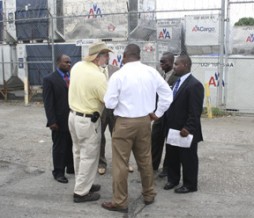
Richard Kurin (in yellow shirt) confers with the security detail at the airport. (Photo by Ken Solomon)
Although this will be a short trip—only two days—we must be vaccinated against typhus and hepatitis A and take pills to ward off malaria. Our agenda calls for us to see a number of historic sites that have been damaged by the earthquake on the first afternoon. In the evening, Haitian President Preval and First Lady Elizabeth Preval have graciously offered to host a reception for us to thank us for our help. The next day will focus on our new recovery center where we will meet with key figures in Haitian cultural circles and be able to visit in person with conservators working to save documents and art.
Our plane flies into Toussaint Louverture International Airport in Port-au-Prince allowing a view of the densely populated valley and hillsides below. Some 3 million people live in Port–au-Prince.We are met by a team coordinated by the very able Olsen Jean Julien, the former Minister of Culture and Communication, who knows the Smithsonian well, having coordinated the Haiti presence at the 2004 Smithsonian Folklife Festival. Olsen is joined by Cori Wegener, president of the U.S. Committee of the Blue Shield, who led efforts to restore art to museums in Iraq after they were ransacked in the early days of the Iraq War. With our luggage in hand we board a van that is escorted by a lead vehicle that is part of our security detail.
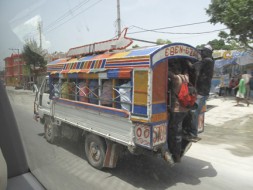
One of the ubiquitous “tap taps” that provide public transportation in Haiti. (Photo by Wayne Clough)
We proceed to the site of the National Cathedral and along the way have our first look at the post-earthquake Port–au-Prince. It does not take long to feel the impact: As we leave the airport grounds through a steel security gate capped by razor wire, the road takes us past a tent village for Haitians who lost their homes. During our stay we will see many more such accommodations. That so many people remain out of their homes six months after the earthquake is an indicator of the level of the disaster this country faces.
Along the way we notice the many entrepreneurs who have set up shop along the roadside. Some who specialize in mobile sales carry what appears to be a miniature drugstore in baskets on their heads with toothbrushes, toothpaste, combs and other sundries. Others repair tires or market plug-in chargers that are handy to use for electronic devices that will be driven by generators because of the lack of electricity from the grid. We are amazed at the combinations of public conveyances on the roads, including the ubiquitous “tap-taps,” pickup trucks pressed into service as mini-buses by adding frames over the truck bed covered by some form of rain resistant material. Not only are the two facing sets of benches inside usually filled, humanity often spills out as men hang on to any place a grip can be had.
Before the earthquake the grand pink-and-white National Cathedral rose more than 100 feet above the streets of Port-au-Prince and was visible from great distances. Worshipers were inspired by the soaring interior arches and the stained glass windows. Today, the cathedral stands in mute testimony to the power of nature over that of man—its majestic arched roof collapsed inwards and the distinctive twin cupolas crashed down to the pavement, lying in a thousand pieces along the steps to the church.
Somehow, many of the stained glass windows remain intact and there is hope they can be saved, but they exist precariously, held in their settings by the remnants of the cathedral walls. To do any work safely inside the cathedral, the walls need to be structurally supported by scaffolding, but this has not yet been constructed.
Our next destination is the Holy Trinity Episcopal Church, which, like the National Cathedral, collapsed during the earthquake. The route takes us through neighborhoods where we can see the devastation that has occurred. Few structures remain standing, rubble has yet to be removed, and people are living under make-shift conditions. Having been to many earthquake sites before, I am surprised that so little visible progress seems to have been made on recovery six months after the quake.
The cathedral of the Holy Trinity Church is famous for murals depicting Biblical stories peopled by Haitians of African descent. Completed in 1951, 15 murals were painted by prominent Haitian artists, including Prefete Duffaud. A mural showing Jesus being baptized in a stream is particularly well known and is central to the recovery effort. The Church as an entity was established in 1863 and has shown remarkable resilience over time given that its buildings have been destroyed five times by a range of manmade and natural causes. Little remains of the cathedral other than portions of the walls that flanked the great hall.

Rachel Goslins, executive director of the President’s Committee on Arts and Humanities, inspects one of three surviving murals at Holy Trinity Episcopal Church. (Photo by Ken Solomon)
In contrast to other sites we have seen, some of the rubble has been removed so that we can walk through the central area. The remaining rubble shows that the walls of the church were made of large river-deposited cobbles that are rounded by the journey from the mountains to the valley. The cobbles were stacked and held together with cement. This type of construction is common in poorer countries, but does not lend itself to efficient reinforcing against the lateral shear of earthquake forces. We can see pieces of the cathedral walls painted with the famous murals lying among the rubble. Now, only three of the murals remain precariously intact where the walls managed to avoid collapse, including the one showing Jesus being baptized in the stream.
Light timber scaffolding has been built to allow inspection of the murals, but it provides little to no protection against a possible collapse of the remaining walls. The engineer in me reminds my enthusiastic art colleagues to use caution as they close in to examine the murals. The humanist in me is moved by the remarkable murals that stand in front of us in such fragile condition. I learn that the remaining murals represent one project that the team working with the Recovery Project will address starting next week. I am also pleased to hear that a good friend of mine, Dr. Reginald DesRochers, a well known structural and earthquake engineer from Georgia Tech, will assist in making assessments of the structural support needed to allow assessment of the condition of the murals. Dr. DesRochers, or Reggie, was born in Haiti and speaks Creole. His family moved to New York City when he was young and became part of the Haitian Diaspora—more than 800,000 people of Haitian descent live in Canada and the United States.
As we prepare to leave the Church, we hear music and walk towards the sound. Under a light portico that remains standing is a children’s orchestra practicing with instruments spared by the earthquake. In the room of a nearby small building, a children’s choir sings. The entryway to the room is partially blocked by twisted metal, the remains of what was once the largest pipe organ in the Caribbean. The emotional impact of these scenes is strong, adding to the understanding of why we are here.
The next stop is the Nader Museum, a prominent private museum. On our way we stop at the Presidential Palace, an ornate building widely seen around to world as representing Haiti. Its collapse is the most prominent public face of the earthquake. We have little time to spend other than to take in the magnitude of the loss of this beautiful building. Across the street from the Palace is another of the many tent cities in Port-au-Prince. We wonder how the people who are staying here manage to find the daily necessities. As we prepare to leave a young man approaches with art works in his hands, hoping to sell them. We have no way to carry the work with us and have to turn him down, but we are reminded yet again of how important art is to a people who have little else.
The Nader Museum is in a part of Port-au- Prince that was heavily hit by the earthquake. All along the route to its location we continue to see collapsed buildings and the rubble is piled high on every street. We are met at the museum site by Georges Nader, whose family owns the museum and a gallery downtown. The museum itself is no more. What remains is rubble and within the rubble scraps of paintings can be found, representing what once were important works of art. One person was killed when the quake hit, but Georges’ parents, who were sleeping in a room below the main structure, were spared. The new car Georges had given to them for Christmas was crushed as the building collapsed and its flattened remains lie in the yard.

Mold damage can be seen on these paintings saved from the collapse of the Nader Museum. (Photo by Wayne Clough)
Not all was lost in the collapse of the Museum. Several hundreds of paintings were saved, but they are stacked like cordwood in rooms that lie below the museum site itself. All are at risk since the rooms have no air conditioning or humidity control and mold is growing in the dank spaces, covering the paintings.
There is hope the Recovery Project can help save some of these paintings. Georges is working with the Smithsonian and donors who have generously provided funding for canvases, paint and brushes that are being freely given to Haitian artists to help them get back to their work and earn income again. We leave the Nader Museum site with a sobered sense of how large the task ahead really is. In this one location there are hundreds of works of art that need attention and help.
The last visit of this day takes us to the site of the Centre D’Art, a center that was used to both house art and provide space for artists to learn and to paint. The building that was the Centre D’Art consisted of a hybrid structure, part wooden frame and part masonry. Before the quake, the building had the appearance of a handsome mansion, but afterwards, all that is left are a few walls and the rear part of the building that looks as if a giant cleaved the front off with a large axe. Somehow, the rear of the building managed to remain upright and its floors gape as if waiting for someone to close a wound. We are told that paintings and other art were rescued by daring young men who were willing to enter the damaged structure in the days following the quake when aftershocks were a common phenomenon. Today the art from the Centre is housed in a series of steel containers with the site itself protected by armed guards. The containers bake in the sun and provide no humidity control. Clearly, this is an unacceptable proposition for the long term and is yet another case in point for the Recovery Project.
We prepare to depart to our hotel a few miles away in Petionville only to find that one of the vans we are traveling in has the keys locked inside. Several of us decide to go ahead by riding in the pickup truck that is the lead vehicle of our security detail. Ken Solomon, a member of the President’s Committee on the Arts and the Humanities, and I position ourselves in the back of the truck with an unfettered view of the surroundings. We quickly realize our ride requires vigilance. “Duck” is the operative word when approaching power poles that lean precariously toward the road bearing live wires that dangle at street level. “Hold on” is a worthy notion as the truck gets going up the hills and gains speed while dodging around slower vehicles and playing a game of chicken with pedestrians and motorcyclists who seemingly believe our driver really would avoid them if push came to shove.
We also have a view of the famous Port-au-Prince hillside slums, a dystopian vision of housing climbing the hillsides as one house is built on top of another. Following no codes for either structural support or sanitation, the houses are ready-made to become part of the story of the disaster from the next earthquake or hurricane. Hundreds collapsed during the recent quake.
Our open air ride also affords a view of the entrepreneurial art culture of Haitians. On every available wall that is near a hotel or population center, artists have their paintings on display. Crafts cleverly made from materials recycled from debris recovered from the earthquake rubble dangle from stanchions. I am not sure how many of the hundreds of these pieces are sold, but assume that it only takes a few to make the effort worthwhile. The higher up the hill we go, the fewer the number of collapsed buildings we see. Our comfortable accommodation in Petionville, the Kinam Hotel, escaped major damage but across the street, there is another tent village of people who lost their homes.
After a brief moment to unload our bags and clean up, we are off again, climbing further up the mountain to a reception in our honor hosted by President Preval and the First Lady of Haiti. The Presidential Palace as well as their private residences were destroyed in the earthquake so the reception is held at the home of a friend. The American Ambassador, Ken Mertens and his wife, are present along with several Haitian dignitaries. The agenda focuses on the art of Haiti and we enjoy performances by groups of children and teens as well as a folk group of troubadours. Our Broadway League members are moved to begin thinking about ways to bring performers such as these to the attention of the larger world.
The First Lady graciously expresses appreciation on behalf of the Haitian people for the work of the Haitian Cultural Recovery Project. Margo Lion, co-chair of the President’s Committee, Paul Libin, head of the Broadway League, and Marsha Semmel, acting director of the Institute for Museum and Library Services, and I speak about our intentions to continue our efforts until we have established a solid base that can be sustained by the Haitians themselves. I also present Elizabeth Preval with hundreds of pictures expressing good wishes to Haiti’s children drawn by visitors to a Smithsonian exhibition of drawings by children of a Haitian school, Plas Timoun, currently at the Ripley Center organized by our National Museum of African Art. In the main, they reflect American children reaching their hands out to help and encourage the children of Haiti. The First Lady’s spirits soar. Later, Richard Kurin and I have a brief private audience with the President and the First Lady to exchange personal greetings and the evening comes to a close.

Haitian President Rene Preval and First Lady Elizabeth Preval (center right) host members of the U.S. President’s Committee for the Arts and the Humanities along with staff of the Smithsonian’s Haitian Cultural Recovery Project at their residence ouside of Port-au-Prince.
On stepping out of the hotel to board our van the next morning, I find an artistic entrepreneur has covered 20 yards or so of an adjacent stone wall with paintings and offers butterflies made of scrap metal painted with bright island colors. I can’t resist buying a butterfly and the sale is transacted. My new best friend has a wonderful smile and encourages me to acquire another piece. Given that my luggage is packed already, I decline, but I have enjoyed being reminded yet again of the importance of art to this nation and its limping economy.
Because we have an afternoon flight and time is required to clear customs, we have only the morning on our second day. This is devoted to a visit to the site of the new headquarters building for the Recovery Project and a meeting with Haitian cultural leaders to exchange views about how our work should proceed and to allow us to hear about the concerns and hopes of our Haitian friends. Locating a suitable building for the headquarters was no easy task in itself. It had to be safe from aftershocks and hurricanes, secure, for lease, and large enough to house the offices and art recovery work. A group of Smithsonian facilities folks, headed by Mike Bellamy, have done an admirable job of finding what is needed. We all are impressed by the site, which is well protected from the street and provides the space needed with good working conditions. Steady power is supplied by generators, insuring our workers have adequate humidity and temperature control. Inside are basic field labs with equipment, materials and supplies for safeguarding and restoring paintings, artifacts and documents.
In addition to Olsen Jean Julien and Cori Wegener, we have been fortunate to have Stephanie Hornbeck, recently retired former conservator for our National Museum of African Art, as the Chief Conservator. This is a labor of love for Stephanie who has taken the position out of a desire to contribute to the cause. Olsen, Cori and Stephanie form a redoubtable team for our work at the Recovery Center. Added to their good efforts, there are many volunteers who come and go, including people like Hugh Shockey of the Smithsonian American Art Museum, who spent a several-week stint recently and wrote a much-followed blog about his work and Gail Joyce, a registrar with the National Museum of the American Indian who worked with Haitian Carmelita Douby to set up the Center’s registration system. Today we meet with volunteer conservators Beverly Perkins from the Buffalo Bill Museum in Cody, Wyoming, Karen Pavelka from the University of Texas, and David Goist from Raleigh, North Carolina. Organized by the American Institute for Conservation, they are lending their expertise to the restoration efforts. American conservators have already restored paintings by the famed Haitian artist Hector Hyppolite, pre-Colombian Taino statues, and documents from the era of Haiti’s independence. Paintings that lliterally were in pieces days ago are now put back together—and unless you are an expert, it is hard to tell they were actually damaged.
Conservators are also testing pieces of the damaged murals from the Episcopal Church in order to figure out how the murals might best be saved. In August, the project plans to begin training Haitians in earnest. If three or four dozen Haitians can learn the basics of conservation arts and sciences, they can play a strong and needed role in preserving their own cultural heritage. Training the Haitians themselves is the only way to really address the scale of the task with literally tens of thousands of paintings, artifacts, documents, videos, photographs and other items to preserve.
At the Center, we meet with a number of Haitian cultural leaders to discuss the recovery efforts underway, what is needed at a grand scale, and the obstacles to success. The group includes Michelle Pierre Louis, the former Prime Minister of Haiti and now president of FOKAL, a cultural and educational NGO partnered with the Smithsonian for the project. Patrick Vilaire, a sculptor and a Smithsonian Research Associate, tells us harrowing tales of how he went into the rubble in the days after the earthquake to rescue an important collection of historical books. Others, from churches, archives, museums and galleries tell us their stories.

The discussions about how best to proceed are productive. Here, members of the team listen intently to Patrick Delatour. (Photo by Ken Solomon)
Our discussions are productive. Richard reviews where the Recovery Project is and how our arrangement for the new project center works. Our Haitian colleagues are able to express their points of view about what they see as opportunities and challenges, and on our side good questions are asked. We explore how we can work collaboratively with all of the key arts organizations in Haiti and with the relevant government agencies. Patrick Delatour gives a concise overview of the many groups involved, their areas of governance, and the role of the initiative being led by former President Bill Clinton. The issue of provision for a longer term solution for storage of the recovered art that will allow for temperature and humidity control is discussed and options are suggested. It is not an easy problem to solve. We can save hundreds, maybe thousands of Haiti’s treasures. With the help of those we train, the number may reach the tens of thousands. Yet the buildings and facilities to re-house these treasures either do not exist or are inadequate. The solution for the art, just as for the whole society, will entail rebuilding a stronger, more sustainable Haiti.
The discussions are followed by a press conference. Rachel Goslins, Executive Director of the President’s Committee, joins Minister Delatour, Olsen and Richard, as word of the project is spread to Haitians via television, radio and the newspapers.

A volunteer conservator explains how historic documents will be restored and preserved. (Photo by Ken Solomon)
We visit the recovery facilities and are given close-up looks at the preservation and restoration work for documents and artwork. One of the documents is the record of service of Alexander Petion, who was a revolutionary hero and served as president of the southern part of Haiti from 1806 until his death. The frame and the document itself are being treated for damages. Paintings are also being repaired, albeit somewhat slowly given that only a few volunteers are on site in this start-up phase. Regardless, their work is critical given the size of the problem and the need to take action as early as possible.
We conclude our trip with a greater understanding of the issues and the possibilities for Haiti’s cultural recovery. We’ve helped build bridges between good-willed cultural leaders of the United States and our Haitian colleagues who have the strongest interest in seeing that culture inspire a brighter future. Amidst all the devastation and tragedy wrought by the earthquake, I’m proud the Smithsonian has played such a positive role on the road to Haiti’s recovery. We depart from the Recovery Center on time and head for the airport.
As we drive towards our destination, schools are letting students out and we see the laughing and smiling faces of Haitian children wearing school uniforms. I feel that what we are doing will help this generation of young Haitians and those to come be inspired by their cultural patrimony and feel a stronger connection to their history. And that it is right that the Smithsonian is here.
Posted: 28 July 2010
- Categories:
